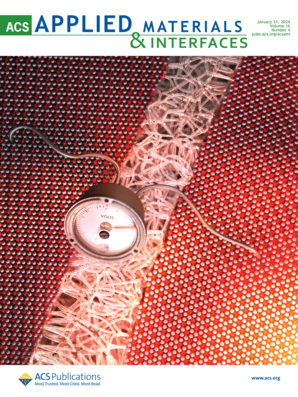Self-Powered Flexible Triboelectric Nanogenerators for Real-Time, Adaptive Gesture-Based Emergency Communication.
IF 8.3
2区 材料科学
Q1 MATERIALS SCIENCE, MULTIDISCIPLINARY
引用次数: 0
Abstract
The triboelectric nanogenerator (TENG) represents a distinctive energy harvesting technology. However, polymer-based TENG faces substantial challenges in retaining stable triboelectric output and structural robustness across temperature extremes and humidity gradients. These limitations stem from inherent material degradation and interfacial charge dissipation under harsh conditions. This study presents a TENG composed of an aromatic polyamide nanofiber membrane doped with carbon nanotubes and barium titanate (CB-PMIA), and a reduced graphene oxide-doped nanomembrane of poly(3,4-ethylene dioxythiophene):poly(styrenesulfonate) (rGO-PP). The resulting CB-PMIA/rGO-PP nanocomposite offers excellent thermal stability, mechanical stability, thermal and moisture comfort, and a tunable triboelectric output performance. Under standardized testing conditions (2 Hz frequency, 35 N applied pressure), the CB-PMIA/rGO-PP TENG demonstrated an open-circuit voltage of 158 V and a short-circuit current of 1.6 μA. Concurrently, it generated a maximum peak power density of 1.2 W m-2 under a 20 MΩ resistive load, highlighting its superior energy conversion efficiency in practical operating scenarios. Importantly, the TENG maintains stable output performance across a wide temperature range (-30 to 200 °C) and humidity levels (relative humidity of 45 to 95%), even sustaining 84.9% and 76% of output at 200 and -30 °C, respectively. This research introduces an innovative framework for sustainable energy harvesting in extreme operational environments. Through optimized interfacial charge transfer efficiency, the developed device seamlessly integrates with low-power Bluetooth Low Energy sensing modules, enabling real-time wireless sensory data acquisition for human motion analysis. The system supports both gesture-recognition-based hierarchical alerting mechanisms and multimodal safety monitoring, demonstrating robust environmental adaptability and signal stability under simulated harsh conditions. This advancement paves the way for the development of advanced human-machine collaborative safety systems capable of operating in extreme temperature and humidity environments.用于实时、自适应手势应急通信的自供电柔性摩擦电纳米发电机。
摩擦电纳米发电机(TENG)代表了一种独特的能量收集技术。然而,基于聚合物的TENG在极端温度和湿度梯度下保持稳定的摩擦电输出和结构坚固性方面面临着重大挑战。这些限制源于在恶劣条件下固有的材料降解和界面电荷耗散。本研究提出了一种由碳纳米管和钛酸钡掺杂的芳香族聚酰胺纳米纤维膜(CB-PMIA)和还原氧化石墨烯掺杂聚(3,4-乙烯二氧噻吩):聚苯乙烯磺酸钠(rGO-PP)纳米膜组成的TENG。得到的CB-PMIA/rGO-PP纳米复合材料具有优异的热稳定性、机械稳定性、热湿舒适性和可调的摩擦输出性能。在标准化测试条件下(2 Hz频率,35 N施加压力),CB-PMIA/rGO-PP TENG的开路电压为158 V,短路电流为1.6 μA。同时,在20 MΩ电阻性负载下,产生的最大峰值功率密度为1.2 W m-2,在实际运行场景中突出了其优越的能量转换效率。重要的是,TENG在宽温度范围(-30至200°C)和湿度水平(相对湿度为45至95%)下保持稳定的输出性能,甚至在200°C和-30°C下分别保持84.9%和76%的输出。本研究介绍了一种在极端操作环境下可持续能源收集的创新框架。通过优化界面电荷传输效率,开发的设备与低功耗蓝牙低功耗传感模块无缝集成,实现实时无线传感数据采集,用于人体运动分析。该系统支持基于手势识别的分层报警机制和多模式安全监测,在模拟的恶劣条件下展示了强大的环境适应性和信号稳定性。这一进步为能够在极端温度和湿度环境下运行的先进人机协作安全系统的发展铺平了道路。
本文章由计算机程序翻译,如有差异,请以英文原文为准。
求助全文
约1分钟内获得全文
求助全文
来源期刊

ACS Applied Materials & Interfaces
工程技术-材料科学:综合
CiteScore
16.00
自引率
6.30%
发文量
4978
审稿时长
1.8 months
期刊介绍:
ACS Applied Materials & Interfaces is a leading interdisciplinary journal that brings together chemists, engineers, physicists, and biologists to explore the development and utilization of newly-discovered materials and interfacial processes for specific applications. Our journal has experienced remarkable growth since its establishment in 2009, both in terms of the number of articles published and the impact of the research showcased. We are proud to foster a truly global community, with the majority of published articles originating from outside the United States, reflecting the rapid growth of applied research worldwide.
 求助内容:
求助内容: 应助结果提醒方式:
应助结果提醒方式:


